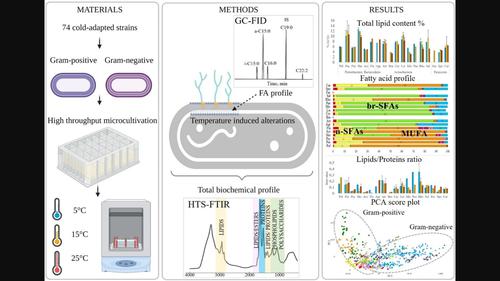当前位置:
X-MOL 学术
›
Environ. MicroBiol. Rep
›
论文详情
Our official English website, www.x-mol.net, welcomes your feedback! (Note: you will need to create a separate account there.)
Explorative characterization and taxonomy-aligned comparison of alterations in lipids and other biomolecules in Antarctic bacteria grown at different temperatures
Environmental Microbiology Reports ( IF 3.3 ) Pub Date : 2024-02-03 , DOI: 10.1111/1758-2229.13232 Volha Akulava 1 , Margarita Smirnova 1 , Dana Byrtusova 1 , Boris Zimmermann 1 , Dag Ekeberg 2 , Achim Kohler 1 , Uladzislau Blazhko 1 , Uladzislau Miamin 3 , Leonid Valentovich 4 , Volha Shapaval 1
Environmental Microbiology Reports ( IF 3.3 ) Pub Date : 2024-02-03 , DOI: 10.1111/1758-2229.13232 Volha Akulava 1 , Margarita Smirnova 1 , Dana Byrtusova 1 , Boris Zimmermann 1 , Dag Ekeberg 2 , Achim Kohler 1 , Uladzislau Blazhko 1 , Uladzislau Miamin 3 , Leonid Valentovich 4 , Volha Shapaval 1
Affiliation

|
Temperature significantly impacts bacterial physiology, metabolism and cell chemistry. In this study, we analysed lipids and the total cellular biochemical profile of 74 fast-growing Antarctic bacteria grown at different temperatures. Fatty acid diversity and temperature-induced alterations aligned with bacterial classification—Gram-groups, phylum, genus and species. Total lipid content, varied from 4% to 19% of cell dry weight, was genus- and species-specific. Most bacteria increased lipid content at lower temperatures. The effect of temperature on the profile was complex and more species-specific, while some common for all bacteria responses were recorded. Gram-negative bacteria adjusted unsaturation and acyl chain length. Gram-positive bacteria adjusted methyl branching (anteiso-/iso-), chain length and unsaturation. Fourier transform infrared spectroscopy analysis revealed Gram-, genus- and species-specific changes in the total cellular biochemical profile triggered by temperature fluctuations. The most significant temperature-related alterations detected on all taxonomy levels were recorded for mixed region 1500–900 cm−1, specifically the band at 1083 cm−1 related to phosphodiester groups mainly from phospholipids (for Gram-negative bacteria) and teichoic/lipoteichoic acids (for Gram-positive bacteria). Some changes in protein region were detected for a few genera, while the lipid region remained relatively stable despite the temperature fluctuations.
中文翻译:

不同温度下生长的南极细菌脂质和其他生物分子变化的探索性表征和分类学比较
温度显着影响细菌生理学、新陈代谢和细胞化学。在这项研究中,我们分析了在不同温度下生长的 74 种快速生长的南极细菌的脂质和总细胞生化特征。脂肪酸多样性和温度引起的变化与细菌分类(革兰氏菌群、门、属和种)一致。总脂质含量为细胞干重的 4% 至 19%,具有属和种特异性。大多数细菌在较低温度下会增加脂质含量。温度对曲线的影响是复杂的并且更具物种特异性,同时记录了所有细菌的一些常见反应。革兰氏阴性细菌调整不饱和度和酰基链长度。革兰氏阳性细菌调整甲基支化(反异/异)、链长和不饱和度。傅里叶变换红外光谱分析揭示了温度波动引发的总细胞生化谱中革兰氏、属和种特异性的变化。在所有分类水平上检测到的最显着的温度相关变化记录在混合区域 1500–900 cm -1,特别是与主要来自磷脂(对于革兰氏阴性细菌)和磷壁/脂磷壁的磷酸二酯基团相关的1083 cm -1处的条带酸(针对革兰氏阳性菌)。一些属的蛋白质区域发生了一些变化,而尽管温度波动,脂质区域仍保持相对稳定。
更新日期:2024-02-03
中文翻译:

不同温度下生长的南极细菌脂质和其他生物分子变化的探索性表征和分类学比较
温度显着影响细菌生理学、新陈代谢和细胞化学。在这项研究中,我们分析了在不同温度下生长的 74 种快速生长的南极细菌的脂质和总细胞生化特征。脂肪酸多样性和温度引起的变化与细菌分类(革兰氏菌群、门、属和种)一致。总脂质含量为细胞干重的 4% 至 19%,具有属和种特异性。大多数细菌在较低温度下会增加脂质含量。温度对曲线的影响是复杂的并且更具物种特异性,同时记录了所有细菌的一些常见反应。革兰氏阴性细菌调整不饱和度和酰基链长度。革兰氏阳性细菌调整甲基支化(反异/异)、链长和不饱和度。傅里叶变换红外光谱分析揭示了温度波动引发的总细胞生化谱中革兰氏、属和种特异性的变化。在所有分类水平上检测到的最显着的温度相关变化记录在混合区域 1500–900 cm -1,特别是与主要来自磷脂(对于革兰氏阴性细菌)和磷壁/脂磷壁的磷酸二酯基团相关的1083 cm -1处的条带酸(针对革兰氏阳性菌)。一些属的蛋白质区域发生了一些变化,而尽管温度波动,脂质区域仍保持相对稳定。



























 京公网安备 11010802027423号
京公网安备 11010802027423号